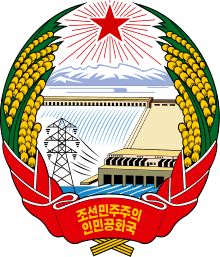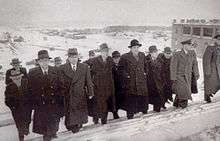Cabinet of North Korea
| Government overview | |
|---|---|
| Formed | 1948 (current, 2013) |
| Jurisdiction | North Korea |
| Headquarters | Pyongyang |
| Minister responsible | |
 |
|---|
| This article is part of a series on the politics and government of North Korea |
|
|
|
Related topics |
The Cabinet of North Korea (Naegak[1]) is, according to the Constitution of North Korea, the administrative and executive body and a general state-management organ in the Government of North Korea.[2] The Cabinet's principal newspaper is Minju Choson.
History

In North Korea's first constitution, adopted in 1948, the executive powers were vested in the Cabinet, chaired by Kim Il-sung himself. The 1972 constitution saw the establishment of the post of President of North Korea which led the executive branch, and the cabinet was split into two organizations: The Central People's Committee and the State Administration Council. The Central People's Committee provided the highest visible institutional link between the government and the party and serves in effect as a de facto super-cabinet. The National Defence Commission was then sub-committee of this body.[3] The CPC's formal powers were all-inclusive and it was chaired by the President.[4] Among its responsibilities are formulating domestic and foreign policies, directing the work of the State Administration Council and its local organs, directing the judiciary, ensuring the enforcement of the constitution and other laws, appointing or removing the vice premiers and cabinet members, establishing or changing administrative subdivisions or their boundaries, and ratifying or abolishing treaties signed with foreign countries. The CPC also may issue decrees, decisions, and instructions. The State Administration Council was guided by the CPC and was led by a premier (chong-ri) and included vice premiers (bochong-ri), ministers (boojang), committee chairmen, and other cabinet-level members of central agencies. It was responsible for the formulation of state economic development plans and measures for implementing them, the preparation of the state budget, and the handling of other monetary and fiscal matters.[5]
1982 saw the People's Armed Forces and Public Security Ministries assigned directly to the President together with the State Inspection Commission.
In 1990, by a CPC decision, the NDC became fully independent from it as a separate institution, and 1992 constitutional amendments assigned it directly to the Supreme People's Assembly. In 1998 amendments to the Constitution, the Central People's Committee and the State Administration were abolished, and the Cabinet was re-created. Thus, the Cabinet is not only the highest executive enforcement organ but was also expanded to become the general State management organ.
Emphasizing its expanded role, on January 1999 Kim Jong-il stated that
"The party organizations and party cadres should not intervene in administrative matters. The party should help the cabinet to be responsible for all economic affairs. Last year we made a new governmental system where the cabinet is supposed to be the control tower of the economy...No organizational unit should handle economic problems without consulting the cabinet".[6]
Selection
The cabinet is appointed and accountable to the Supreme People's Assembly, the North Korean unicameral parliament. The SPA chooses the Premier of North Korea who appoints three vice premiers and the cabinet's ministers. All members of the cabinet are members of the Workers' Party of Korea which rules the country since its establishment in 1948. While the SPA is not in session, the cabinet is accountable to the Presidium of the Supreme People's Assembly.[7]
As of 2000, some 260 people have served in the cabinet. Six of them have been women,[8] including Ho Jong-suk (Minister of Culture and, later, of Justice)[9] and Pak Chong-ae (Minister of Agriculture).[10]
Powers and responsibilities
The Cabinet, as the executive branch of the North Korean state, is responsible for implementing the state's economic policies, as guided by the Workers' Party. The cabinet is not responsible for defense and security issues, as those are handled by the National Defense Commission. Thus, the security organizations such as the Korean People's Army, Ministry of People's Security and State Security Department report and subordinated directly to the National Defense Commission. The Cabinet convenes a plenary meeting and an executive meeting.[11] The plenary meeting consists of all the Cabinet members, while the executive meeting is kind of a presidium, and comprises fewer people, including the Premier, vice premier and other Cabinet members whom the Premier nominates. The cabinet forms acts in the form of decisions and directives. The Cabinet shall:[12]
- adopt measures to execute state policy.
- institute, amend, and supplement regulations concerning state management based on the Constitution and departmental laws.
- guide the work of the Cabinet commissions, ministries, direct organs of the Cabinet, local people’s committees.
- set up and remove direct organs of the Cabinet, main administrative economic organizations, and enterprises, and adopt measures to improve the State management structure.
- draft the State plan for the development of the national economy and adopt measures to put it into effect.
- compile the State budget and adopt measures to implement it.
- organize and exercise works in the fields of industry, agriculture, construction, transportation, communications, commerce, trade, land management, city management, education, science, culture, health, physical training, labor administration, environmental protection, tourism and others.
- adopt measures to strengthen the monetary and banking system.
- do inspection and control work to establish a state management order.
- adopt measures to maintain social order, protect State and social cooperation body’s possession and interests, and to guarantee citizens’ rights.
- conclude treaties with foreign countries, and conduct external activities.
- abolish decisions and directions by economic administrative organs, which run counter to the Cabinet decisions or directions.
At a local level, the Cabinet supervises the Local People's Committees.
Structure
| Position[13] | Name | Ref. |
|---|---|---|
| Premier | Pak Pong-ju | [14] |
| Vice Premier | Im Chol-ung | [14] |
| Vice Premier | Jon Kwang-ho | [14] |
| Vice Premier | Kim Tok-hun | [14] |
| Vice Premier | Ko In-ho | [14] |
| Vice Premier | Ri Ju-o | [14] |
| Vice Premier | Ri Mu-yong | [14] |
| Vice Premier | Ri Ryong-nam | [14] |
| Vice Premier | Ro Tu-chol | [14] |
| Vice Premier | Tong Jong-ho | [14] |
| Secretary General of the Cabinet Secretariat | Kim Yong-ho | [14] |
| Minister of Agriculture | Ko In-ho | [14] |
| Minister of Atomic Energy and Industry | Wang Chang-uk | [14] |
| Minister of Chemical Industry | Jang Kil-ryong | [14] |
| Minister of Coal Industry | Mun Myong-hak | [14] |
| Minister of Commerce | Kim Kyong-nam | [14] |
| Minister of Common Education | Kim Sung-du | [14] |
| Minister of Construction and Building-Materials Industries | Tong Jong-ho | [14] |
| Minister of Culture | Pak Chun-nam | [14] |
| Minister of Electric Power Industry | Kim Man-su | [14] |
| Minister of Electronics Industry | Kim Jae-song | [14] |
| Minister of External Economic Relations | Kim Yong-jae | [14] |
| Minister of Finance | Ki Kwang-ho | [14] |
| Minister of Fisheries | Song Chun-sop | [14] |
| Minister of Food and Consumer Goods Industries | Jo Yong-chol | [14] |
| Minister of Food Procurement and Administration | Mun Ung-jo | [14] |
| Minister of Foreign Affairs | Ri Yong-ho | [14] |
| Minister of Forestry | Han Ryong-guk | [14] |
| Minister of Higher Education | Thae Hyong-chol | [14] |
| Minister of Labor | Jong Yong-su | [14] |
| Minister of Land and Environmental Protection | Kim Kyong-jun | [14] |
| Minister of Land and Maritime Transport | Kang Jong-gwan | [14] |
| Minister of Light Industry | Choe Il-ryong | [14] |
| Minister of Machine-Building Industry | Ri Jong-guk | [14] |
| Minister of Metallurgical Industry | Kim Chung-gol | [14] |
| Minister of Mining Industry | Ri Hak-chol | [14] |
| Minister of Oil Industry | Pae Hak | [14] |
| Minister of Physical Culture and Sports | Kim Il-guk | [14] |
| Minister of Post and Telecommunications | Kim Kwang-chol | [14] |
| Minister of Public Health | Jang Jun-sang | [14] |
| Minister of Railways | Jang Hyok | [14] |
| Minister of State Construction Control | Kwon Song-ho | [14] |
| Minister of State Natural Resources Development | Ri Chun-sam | [14] |
| Minister of Urban Management | Kang Yong-su | [14] |
| Chairman of the Capital City Construction Commission | Jo Sok-ho | [14] |
| Chairman of the Education Commission | Kim Sung-du | [14] |
| Chairman of the State Commission of Quality Management | Ri Chol-jin | [14] |
| Chairman of the State Inspection Commission | N/A | [14] |
| Chairman of the State Planning Commission | Ro Tu-chol | [14] |
| Chairman of the State Price Commission | Ryang Ui-gyong | [14] |
| Chairman of the State Science and Technology Commission | Ri Chung-gil | [14] |
| Director of the Central Statistics Bureau | Choe Sung-ho | [14] |
| President of the State Academy of Sciences | Jang Chol | [14] |
| President of the Central Bank | Kim Chon-gyun | [14] |
See also
References
- ↑ "The World Factbook". Central Intelligence Agency: Korea, North. 1 May 2018. Retrieved 9 May 2018.
- ↑ Article 123 of the Constitution of North Korea
- ↑ Article 105 of the 1972 Constitution
- ↑ Articles 100-106 of the 1972 Constitution of North Korea
- ↑ A Country Study: North Korea- 1993- Library of Congress
- ↑ Jae-Cheon Lim. Kim Jong-il's Leadership of North Korea, p. 116
- ↑ Article 125 of the Constitution of North Korea
- ↑ Lankov, Andrei (2015). The Real North Korea: Life and Politics in the Failed Stalinist Utopia. Oxford: Oxford University Press. p. 28. ISBN 978-0-19-939003-8.
- ↑ Barraclough, Ruth (2015). "Red Love in Korea: Rethinking Communism, Feminism, Sexuality". In Rabinowitz, Paula; Barraclough, Ruth; Bowen-Struyk, Heather. Red Love Across the Pacific: Political and Sexual Revolutions of the Twentieth Century. New York: Springer. p. 42. ISBN 978-1-137-50703-7.
- ↑ Park, Kyung Ae (1994). "Women and Revolution in South and North Korea". In Tétreault, Mary Ann. Women and Revolution in Africa, Asia, and the New World. Columbia: University of South Carolina Press. p. 182. ISBN 978-1-57003-016-1.
- ↑ Article 121 of the Constitution of North Korea
- ↑ Article 119 of the Constitution of North Korea
- ↑ "Organizational Chart of North Korean Leadership" (PDF). Seoul: Political and Military Analysis Division, Intelligence and Analysis Bureau; Ministry of Unification. August 2016. p. 2. Retrieved 8 May 2018.
- 1 2 3 4 5 6 7 8 9 10 11 12 13 14 15 16 17 18 19 20 21 22 23 24 25 26 27 28 29 30 31 32 33 34 35 36 37 38 39 40 41 42 43 44 45 46 47 48 49 50 51 52 53 54 "Chiefs of State and Cabinet Members of Foreign Governments: Korea, North - NDE". Central Intelligence Agency. 21 June 2018. Retrieved 28 August 2018.
External links
